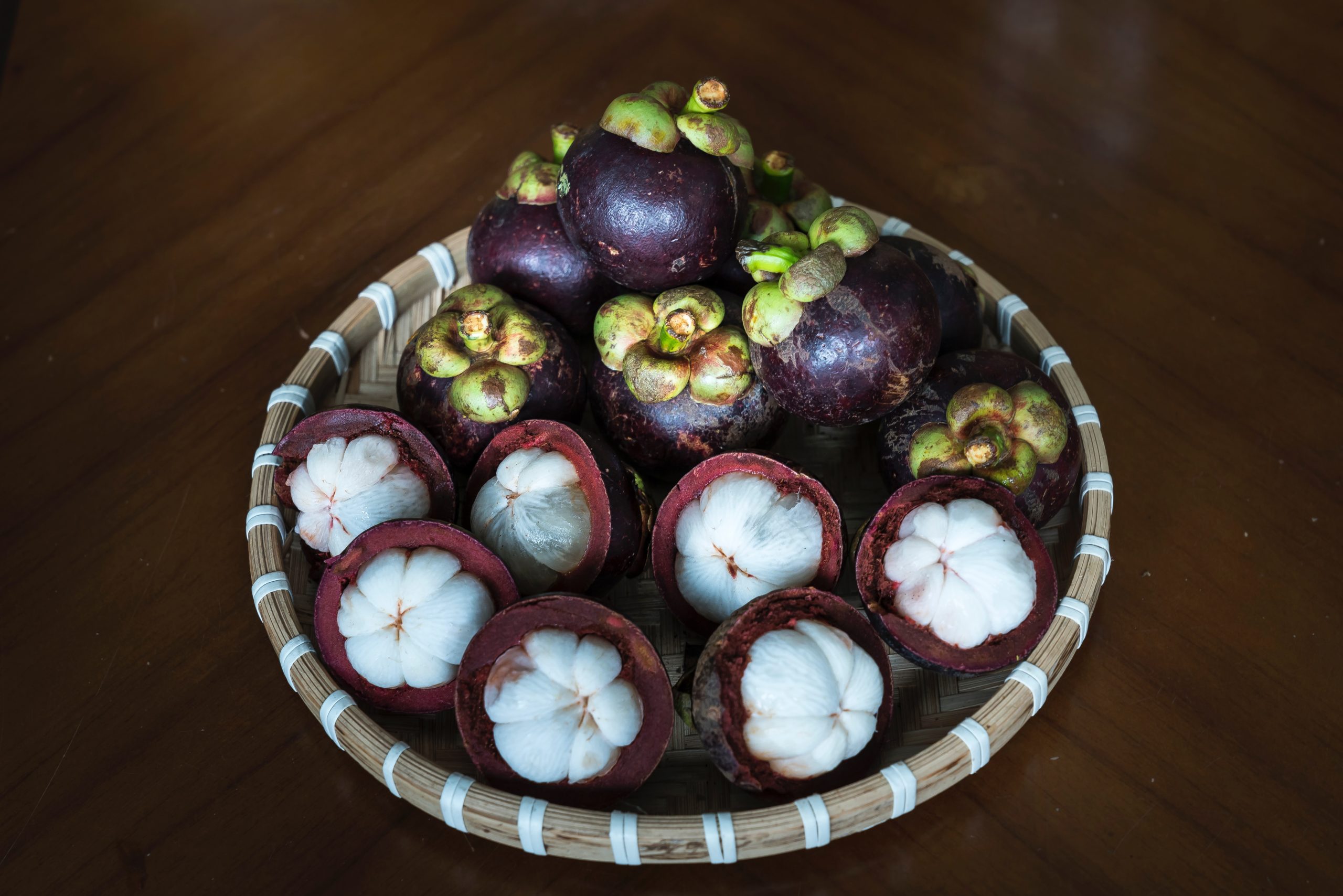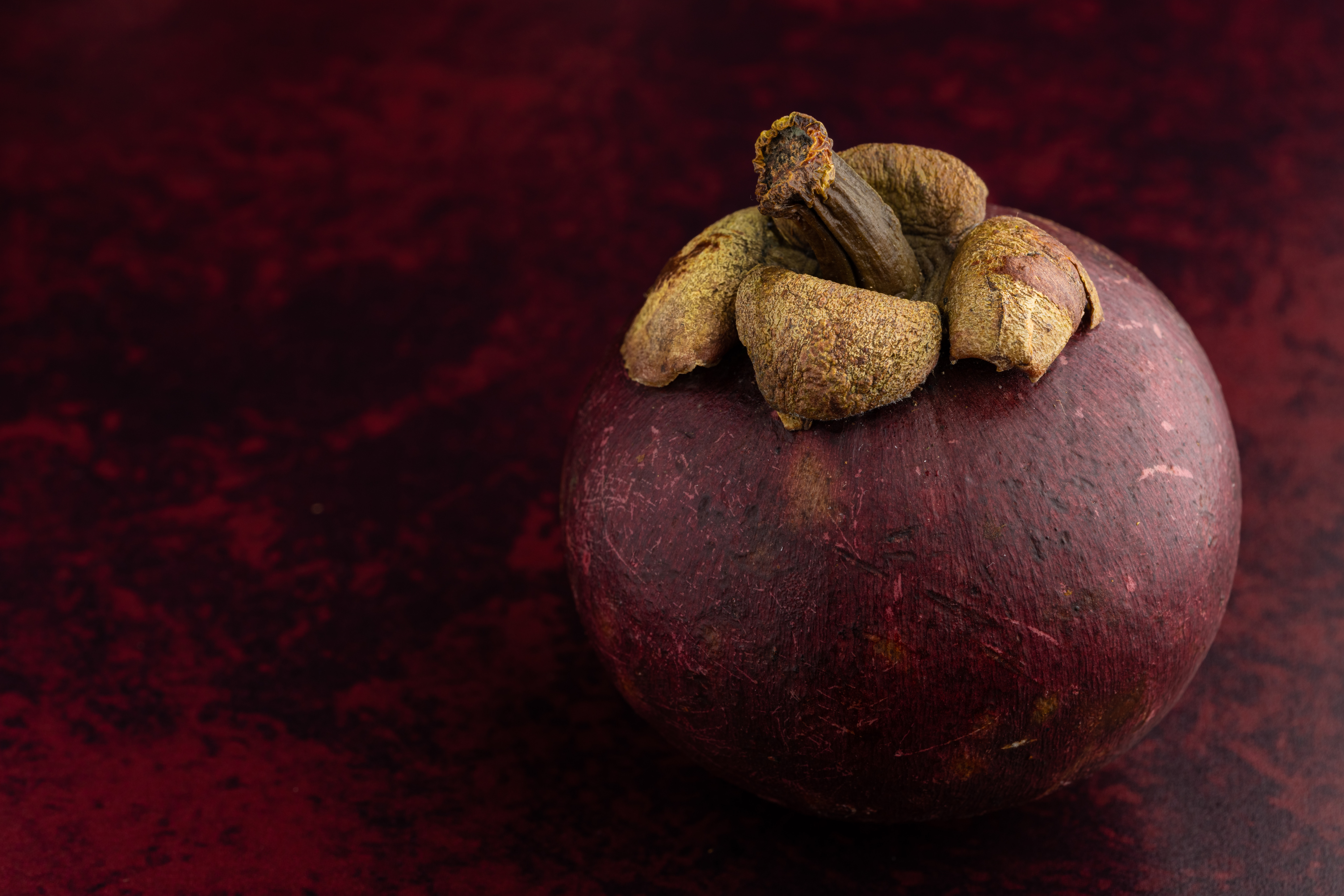The mangosteen is a purple round fruit about the size of a tennis ball, but it has nothing to do with mangos. It doesn’t taste like mangos, and it doesn’t look like them either. The fruit comes from Malaysia. It grows on trees in warm climates, but it is hard to grow because it is so moody. It tastes sweet and just a little bit sour at the same time.
What is a Mangosteen Fruit?
The mangosteen is a tropical fruit that is hard to find. It’s about the size of a clementine, round, smooth, and purple, and its firm skin looks like it can’t be broken. Like a jewel box, that skin protects a treasure inside: tender segments of soft white flesh that are sweet with hints of floral tartness. Mangosteens are expensive and hard to find, so you may wonder how to prepare and eat them, so you don’t waste a single bite. In the end, the best way to eat mangosteen is as simple as possible. Mangosteens taste delicate and have a texture like litchi. They are at their best when served raw and on the half-shell.
Health Benefits of Mangosteen
Here are some benefits of Mangosteen
1. Rich in Powerful Antioxidants
One of the most important things about mangosteen may be its unique antioxidant profile.
Antioxidants are substances that can stop the damage done by molecules called free radicals, which have been linked to several long-term diseases. Vitamin C and folate are two examples of nutrients in mangosteen that can act as antioxidants. Plus, it has xanthones, which are a special type of plant compound with strong antioxidant properties.
In several studies, the antioxidant activity of xanthones has led to anti-inflammatory, anticancer, anti-aging, and anti-diabetic effects. So, xanthones may be behind many of the possible health benefits of mangosteen. Still, there needs to be more research on people before any firm conclusions can be made.
2. May have Anti-Inflammatory Properties
Mangosteen contains xanthones, which may help reduce inflammation.
Studies with test tubes and animals show that xanthones have an anti-inflammatory effect and may lower your risk of diseases like cancer, heart disease, and diabetes that cause inflammation. Mangosteen also has a lot of fiber, which has many health benefits. Some animal research shows, for example, that a diet with more fiber may help your body’s inflammatory response. Even though this information is promising, more research is needed to find out how mangosteen affects inflammation and how diseases get worse in people.
3. May have Anticancer Effects
Population studies show that eating many fruits and vegetables like mangosteen are linked to lower cancer risk. Some plant compounds in mangosteen, like xanthones, have anti-inflammatory and antioxidant effects that may help stop cancer cells from growing and spreading.
Multiple studies in test tubes show that xanthones can stop the growth of cancer cells, including those in the breast, stomach, and lungs. In the same way, a few studies have shown that this compound may slow the growth of colon and breast cancer in mice. Even though these results look good, not enough research has been done on people.
4. May Promote Weight Loss
One of the mangosteen’s main claims to fame in the health and wellness world is that it can help people lose weight.
In one study, mice that ate a high-fat diet and got extra doses of mangosteen gained much less weight than mice that didn’t get any extra mangosteen. In a small, 8-week study, people who added 3, 6, or 9 ounces (90, 180, or 270 ml) of mangosteen juice to their diets twice a day tended to have a lower BMI than the control group.
Fewer studies have been done on mangosteen and obesity, but experts think that the fruit’s anti-inflammatory properties help the body burn fat and prevent weight gain. More research is needed to determine how mangosteen might fit into a plan to lose weight.
5. Supports Blood Sugar Control
Studies on both test tubes and animals show that xanthone compounds in mangosteen may help you keep your blood sugar in a healthy range.
A 26-week study on obese women found that those who took 400 mg of mangosteen extract daily had much less insulin resistance, a risk factor for diabetes, than the control group. The fruit is also a good source of fiber, a nutrient that can help stabilize blood sugar and keep diabetes under control. Combining xanthone and fiber in mangosteen may help keep blood sugar levels even. Still, more research is needed.
6. Promotes a Healthy Immune System
Mangosteen has fiber and vitamin C, which are important for a healthy immune system.
Fiber helps your healthy gut bacteria, an important part of your immune system. On the other hand, different immune cells need vitamin C to work and have antioxidant properties. Some research also suggests that some plant compounds in mangosteen may have antibacterial properties. This could help your immune health by killing bacteria that could be harmful.
To work well, your immune system needs a lot of different nutrients. As part of a balanced diet, mangosteen may be a healthy choice to eat along with other nutrient-dense foods. In a 30-day study with 59 people, those who took a supplement with mangosteen had fewer signs of inflammation and a much bigger increase in the number of healthy immune cells than those who took a placebo.
7. Helps Maintain Healthy Skin
Sun damage to the skin is common everywhere and is a major cause of skin cancer and other signs of aging. In one study, mice given different mangosteen extracts were found to have skin that was less sensitive to ultraviolet-B (UVB) radiation.
Also, a small human study that lasted three months found that people whose skin was treated with 100 mg of mangosteen extract every day had much more elasticity and less of a compound known to cause the skin to age. Researchers think that mangosteen’s antioxidant and anti-inflammatory properties are the main reason it helps protect the skin, but more research is needed in this area.
Why are Mangosteens So Expensive?
They won’t just grow anywhere. Garcinia mangostana is an ultra-tropical evergreen tree that only grows within 20 degrees of the Equator (not even Florida is sticky enough). The trees have specific needs to grow and produce varying amounts of fruit. They need high temperatures that stay the same, high humidity, and high but not too high rainfall. Saplings need to be in the shade and hate being moved. The trees also take a long time to grow up.
They don’t bloom until six to eight years after they are grown from seeds (compared with papaya, which can produce fruit within a year). The mature trees produce crops every other year. One year, they produce a lot of fruit, and the next year (and maybe the year after that), they produce very few fruits while the tree gets its strength back. The fruit can’t keep getting riper after it’s been picked, so it has to be ready when it’s picked. Also, irradiation costs a lot, which adds to the price of fruit that has been treated.
Where are they Grown?
The mangosteen grows on small trees that always stay green in southern India, Malaysia, Thailand, and Indonesia. Some farmers try to grow the fruit in Hawaii and the Caribbean, but it’s usually hard. People say that Queen Victoria offered a big prize to anyone who could bring mangosteen back to England that could be eaten, but no one could do it.
Most mangosteens can’t be bought or grown in the United States because the rind can carry pests that would hurt other crops. Only mangosteens from Hawaii or Puerto Rico can legally be brought to the United States mainland. The fruit can be brought into Canada legally, and it is also available in Europe and some parts of the Mediterranean. Mangosteen can also be bought in a can, but most people say that the taste doesn’t even come close to that of the fresh fruit.
How to Prepare and Eat Mangosteens?
To eat it, you can crush the hard but moist skin with your palm to get to the white fruit inside. The bitter rind is not edible, and the fruit comes in wedges of different sizes, like garlic. The largest wedge may contain a single bitter seed that is not usually eaten. The number of segments is usually between four and eight, which matches the number of points on the bottom of the fruit. This makes it easy to know how many pieces of fruit are inside before you open it. Usually, the fruit can be kept at room temperature for up to a week, but if it is kept cold, like in the refrigerator, it may last a few days longer.
Mangosteens don’t get better with time, so eat them soon after you buy them. Mangosteens that are still soft and new can be broken open by squeezing them between your palms. But a sharp, serrated knife is needed for most mangosteens that are days or weeks away from their mother tree. Put your fruit on a cutting board and carefully cut a shallow hemisphere around it, careful not to cut into the delicate segments inside. Turn the shell and pull off half of it. When the purple ring comes off, the beautiful white flesh is seen. Put the fruit on a platter and pick each piece with dessert forks. It will be an event to remember.
How to Choose Mangosteen?
Thailand has a lot of mangosteens, which is a tropical fruit. It’s about the size of a tennis ball and has a hard, deep purple shell. This one-of-a-kind fruit tastes sweet and is very soft. It is full of antioxidants and micronutrients. It is sold in stores and markets that sell Asian food.
Good mangosteens have green caps that look healthy and skins that are shiny and smooth. The fruit should be solid and should not have any cracks. Make sure there aren’t any bugs on the fruit, and don’t buy fruit with hardened beads of yellow resin on the outer skin, as these often have spots where the resin has seeped in.
Conclusion
People often say that mangosteen doesn’t taste like anything else they’ve eaten, so it’s best not to make comparisons too literally. People know that the fruit is sweet but has a very slight sour taste. The mangosteen tastes like strawberry, peach, and vanilla ice cream, among other things.


